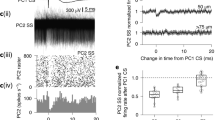Summary
Intracellular recording with microelectrodes has been employed to reveal the causal relationship between the trans-synaptic activation of cerebellar Purkinje cells and the postsynaptic inhibition of Deiters neurones. Cerebellar stimulation produced in Deiters neurones not only monosynaptic IPSPs with latency of 0.9–1.5 msec, but also the delayed IPSPs at 1.5–9 msec. Correspondng to the latter, Purkinje cells were found to be activated orthodromically with the characteristic climbing fibre responses (CFRs), the latency varying from 0.8 up to 10 msec. On the other hand, stimulation of the inferior olive first induced EPSPs in Deiters neurones, presumably monosynaptically, then with a short delay of less than a millisecond CRFs in Purkinje cells of the anterior lobe, which in turn were succeeded by IPSPs in Deiters neurones after a further delay of a millisecond. Spinal stimulation activated the inferior olive trans-synaptically and thereby produced CFRs in Purkinje cells and a sequence of EPSPs and IPSPs in Deiters neurones. Close correlation between these spinal-induced events in both neurone species was further indicated by the concurrence of their fluctuations in intensity, these fluctuations being characteristic of the spino-olivary transmission mechanism. These results strongly support the postulate that the cerebellar Purkinje cells are inhibitory in their action upon Deiters neurones.
Similar content being viewed by others
References
Brodal, A.: Experimentelle Untersuchungen über die olivocerebellare Lokalisation. Z. ges. Neurol. Psychiat. 169, 1–153 (1940).
Cajal, S. Ramón y: Histologie du système nerveux de l'homme et des vertébrés. II 993 pp. Paris: Maloine 1911.
Dow, R.: Cerebellar action potentials in response to stimulation of various afferent connections. J. Neurophysiol. 2, 543–555 (1939).
Eccles, J.C.: The Physiology of Synapses. pp. 38–40. Berlin-Göttingen-Heidelberg: Springer 1964.
—, R. Llinás and K. Sasaki: Excitation of cerebellar Purkinje cells by the climbing fibres. Nature (Lond.) 203, 245–246 (1964).
— The excitatory synaptic action of climbing fibres on the Purkinje cells of the cerebellum. J. Physiol. 182, 268–296 (1966).
Granit, R., and C.G. Phillips: Excitatory and inhibitory processes acting upon individual Purkinje cells of the cerebellum. J. Physiol. 133, 520–547 (1956).
Ito, M., and N. Kawai: IPSP-receptive field in the cerebellum for Deiters' neurones. Proc. Japan Acad. 40, 762–764 (1964a).
—, and M. Yoshida: The cerebellar-evoked monosynaptic inhibition of Deiters' neurones. Experientia (Basel) 20, 515–516 (1964b).
— K. Orata and R. Ochi: Initiation of IPSP in Deiters' and fastigial neurones associated with the activity of cerebellar Purkinje cells. Proc. Japan Acad. 40, 765–768 (1964c).
—, T. Hongo, M. Yoshida, Y. Okada and K. Obata: Antidromic and transsynaptic activation of Deiters' neurones during stimulation of the spinal cord. Jap. J. Physiol. 14, 638–658 (1964d).
—, and M. Yoshida: The origin of cerebellar-induced inhibition of Deiters neurones I. Monosynaptic initiation of the inhibitory postsynaptic potential. Exp. Brain Res. 2, 330–349 (1966).
Jansen, J. Jr.: Afferent impulses to the cerebellar hemispheres from the cerebral cortex and certain subcortical nuclei. Acta physiol. scand. 41, Suppl. 143, 1–99 (1957).
Larsell, O.: The cerebellum of the cat and the monkey. J. comp. Neurol. 99, 135–200 (1953).
Morin, F.: Activation of cerebellar cortex by afferent impulses. Fed. Proc. 15, 133 (1956).
Muskens, L.J.J.: Experimentelle und klinische Untersuchungen über die Verbindungen der unteren Olive und ihre Bedeutung für die Fallrichtung. Arch. Psychiat. Nervenkr. 102, 558–613 (1934).
Ochi, R.: Occurrence of postsynaptic potentials in the inferior olive neurones associated with their antidromic excitation, 23 Int. Physiol. Congr. Tokyo., 944 (1965).
Suda, I., and T. Amano: An analysis of evoked oerebellar activity. Arch. ital. Biol. 102, 156–182 (1964).
Szentágothal-Schlmert, J.:Die Bedeutung des Faserkalibers und der Markscheidendicke im Zentralnervensystem. Z. Anat. Entwickl.-Gesch. 111, 201–223 (1941).
Szentágothai, J., and K. Rajkovits: Über den Ursprung der Kletterfasern des Kleinhirns. Z. Anat. Entwickl.-Gesch. 121, 130–141 (1959).
Author information
Authors and Affiliations
Additional information
The authors wish to thank Dr. M. Yoshida for kindly allowing the use of his experimental data obtained with one of them (M. I.) in this paper. They are also indebted to Prof. Sir John Eccles for kindly reading the manuscript and improving the English.
Rights and permissions
About this article
Cite this article
Ito, M., Obata, K. & Ochi, R. The origin of cerebellar-induced inhibition of Deiters neurones II. Temporal correlation between the trans-synaptic activation of Purkinje cells and the inhibition of Deiters neurones. Exp Brain Res 2, 350–364 (1966). https://doi.org/10.1007/BF00234780
Received:
Issue Date:
DOI: https://doi.org/10.1007/BF00234780




